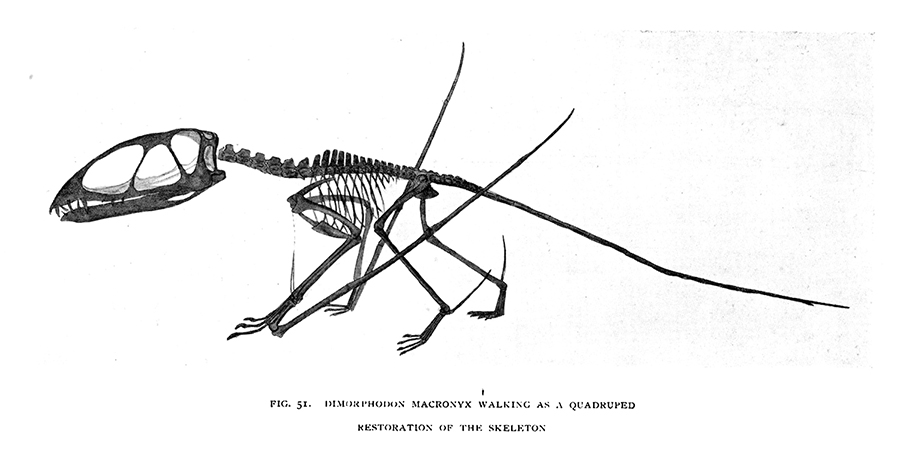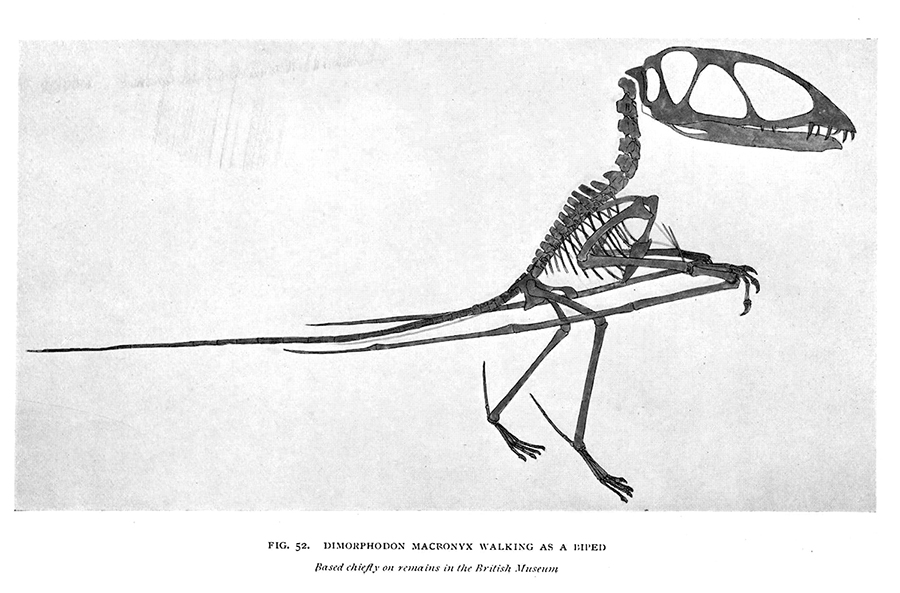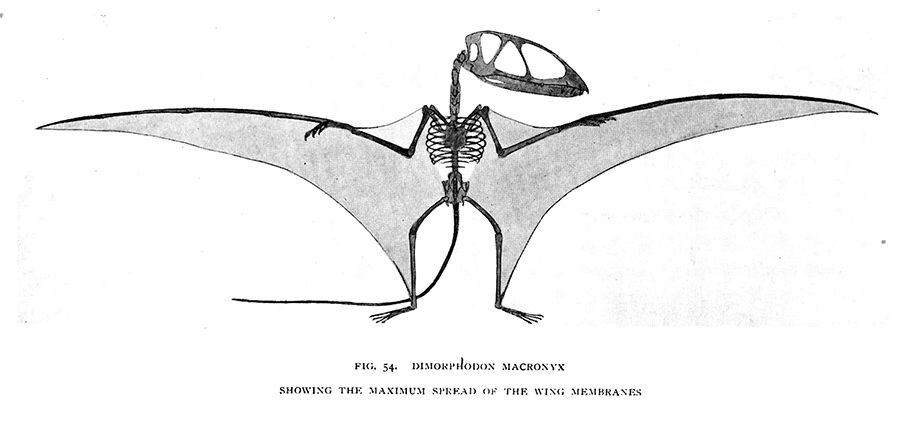Species: macronyx (BUCKLAND, 1829) OWEN, 1859
Etymology: Greek, markos, "long" and Greek, onyx, "claw."
= Pterodactylus macronyx BUCKLAND, 1829
= Pterodactylus (Rhamphorhynchus) macronyx BUCKLAND, 1829 per MEYER, 1846
= Rhamphorhnychus (Pterodactylus) macronyx (BUCKLAND,
1829) MEYER, 1847
= Dimorphodon macronyx (BUCKLAND, 1829) OWEN, 1858 (nomen nudum)
= Rhamphorhynchus macronyx (BUCKLAND, 1829) MEYER,
1847
Holotype: BMNH R 1034
Locality: Lyme Regis coast, Pinhay Bay- Charmouth, (SY 3291-SY 3794), Gloucester County, England, Southern United Kingdom.
Horizon: Lower Liassic.
Biostratigraphy:
Age: Hettangian Stage, Lower Lias Epoch, Lower Early Jurassic.
Material: Skull, coracoid, scapula, Humerus, ulna, radius, metacarpals, phalanges I-III, anterior IV, pelvis, femur, tibia, fibula, metatarsals, 3 caudals and a few dorsal vertebrae, and a jaw fragment.
BMNH R41212: Skeleton.

From Seeley, 1901.

From Seeley, 1901.

From Seeley, 1901.
Referred material:
9182 A: Left maxillary and jugal.
9182 B: Upper jaw fragment.
9182 C: Right humerus.
9182 D: Distal end of first wing-phalanx.
9182 E: Second wing-phalanx.
9182 F: Left femur, missing proximal end.
9182 G: Right femur.
9182 H: Right tibia-fibula.
9182 I: Fused right distal tarsals.
9182 J: Metatarsal.
9182 K: Unidentified shaft fragment near B.
LYDEKKER 1888
BMNH R1034: Fragmentary skeleton.
BMNH R1035: Skull and fragmentary skeleton.
BMNH 41213: Skull.
BMNH 43486-7: 2 imperfect mandibular rami.
BMNH 41346: The entire caudal series.
BMNH R590: Fragmentary skull.
BMNH 42016: Distal end of right humerus.
BMNH 43974: Left humerus.
BMNH R591: Right humerus.
BMNH R1036: Fragmentary left humerus.
BMNH R35: Fragmentary metacarpal.
BMNH 41347: 3 phalangeals of the ulnar digit of manus.
BMNH 42053: A phalangeal of the ulnar digit of manus.
BMNH 43052: A bone probably belonging to the manus.
BMNH 41347a: An imperfect bone which is probably the femur.
BMNH 43973: Fragmentary tibia and fibula.
BMNH 43051,BMNH 41347b: Tibiae and fibulae.
BMNH 47464: Tibia and fibula of a juvenile.
BMNH 41347c: An undetermined long-bone.
BMNH R233: An apparently homologous bones.
Also; OWEN, 1865
Skull and fragmentary skeleton.
Fragmentary skeleton.
Also; UNWIN 1988
GSM 1546: Fragmentary skeleton.
Locality: South bank of the River Severn, Lyme Region, Gloucester County, England, Southern United Kingdom.
Horizon: Lower Liassic.
Biostratigraphy:
Age: Hettangian Stage, Lower Lias Epoch, Lower Early Jurassic.
Material:
Accession Number YPM 456, YPM 350:
350 A: Metacarpal.
350 B: Right tibia-fibula.
350 C: Third wing-phalanx.
350 D: Second wing-phalanx.
350 E: Phalanx of right manus.
350 F: Right humerus.
350 G: Phalanx of pes.
350 H: Right lateral carpal.
350 I: Metatarsals III and IV of left pes.
350 J: Phalanx of right manus.
350 K: ?Partial 4th wing-phalanx of phalanx of 5th toe.
350 L: Metacarpal.
350 M: Left lateral distal tarsal.
350 N: Phalanx of pes.
350 P: Metatarsals II-IV of right pes.
350 R: Left medial distal tarsal.
YPM 9175: Rib ("no.1")
YPM 9176: 2nd wing-phalanx ("No.1")
YPM 9177: ?Ulna ("No. 1")
YPM 9178: Distal end of right humerus ("No. 1")
YPM 9179: 3rd wing-phalanx ("No. 26?")
YPM 9180: Left wing-metacarpal ("No. 18")
Accession number 462, YPM 9181: Distal end of right humerus.
Accession Number 1503, YPM 9182
= Pterodactylus marderi OWEN, 1874 (nomen dubium)
Etymology: In honor of Mr. J. W. Marder of Lyme Regis, England.Holotype: BMNH 41348
Locality: Lyme Regis, Gloucester County, England, Southern United Kingdom.
Horizon: Lower Liassic.
Biostratigraphy:
Age: Hettangian Stage, Lower Lias Epoch, Lower Early Jurassic.
Material: Proximal end of right humerus.
_____________________________________________________________________________________
Species weintraubi CLARK, HOPSON, HERNANDEZ, FASTOVSKY & MONTELLANO, 1998
Etymology: In honor of the late Dr. Robert L. Weintraub.
= Dimorphodon weintraubi CLARK, HOPSON, HERNANDEZ & MONTELLANO, 1997 (nomen
nudum)
= Pterosaur incertae sedis FASTOVSKY & CLARK 1987/CLARK, MONTELLANO, HOPSON,
HERNANDEZ & FASTOVSKY, 1994
Holotype: Universidad Nacional Autonoma de Mexico Instituto Geologia de Mexico, IGM 3494
Locality: Huizachal Canyon, Tamaulpas State, Mexico.
Horizon: Lower part of the La Boca Formation.
Biostratigraphy:
Age: Late Early-Early Middle Jurassic.
Material: Uncrushed partial skeleton. A complete wing (the nearly complete
right wing lacking the proximal part of the humerus and two of the short digit’s),
the left scapulocoracoid and humerus, a partial skull and 4 cervical vertebrae
and an ankle and nearly complete foot, much of the tibia, and what appears
to be a portion of the braincase.